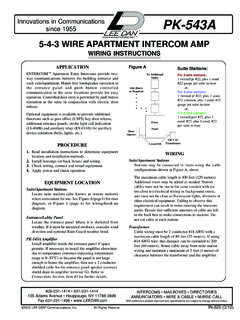Transcription of Review: Synthetic Methods for Amphetamine
1 review : Synthetic Methods for Amphetamine A. Allen1 and R. Ely2 1 Array BioPharma Inc., Boulder, Colorado 80503 2 Drug Enforcement Administration, San Francisco, CA Abstract: This review focuses on synthesis of Amphetamine . The chemistry of these Methods will be discussed, referenced and precursors highlighted. This review covers the period 1985 to 2009 with emphasis on stereoselective synthesis, classical non-chiral synthesis and bio-enzymatic reactions. The review is directed to the Forensic Community and thus highlights precursors, reagents, stereochemistry, type and name reactions. The article attempts to present, as best as possible, a list of references covering Amphetamine synthesis from 1900 -2009.
2 Although this is the same fundamental ground as the recent publication by K. Norman; Clandestine Laboratory Investigating Chemist Association 19, 3(2009)2-39, this current review offers another perspective. Keywords: review , Stereoselective, Amphetamine , Syntheses, references, Introduction: It has been 20 years since our last review of the Synthetic literature for the manufacture of Amphetamine and methamphetamine. Much has changed in the world of organic transformation in this time period. Chiral (stereoselective) Synthetic reactions have moved to the forefront of organic transformations and these stereoselective reactions, as well as regio-reactions and biotransformations will be the focus of this review .
3 Within the synthesis of Amphetamine , these stereoselective transformations have taken the form of organometallic reactions, enzymatic reactions, ring openings, -aminooxylations, alkylations and amination reactions. The earlier review (J. Forensic Sci. Int. 42(1989)183-189) addressed for the most part, the reductive Synthetic Methods leading to this drug of abuse. It could be said that the earlier review dealt with classical organic transformations, roughly covering the period from 1900-1985. This time-line is graphically illustrated below in Figure 1. As illustrated in this figure, certain categories have been historically active.
4 Early Synthetic organic transformations such as aldol condensations, the Hofmann rearrangement [105, 116], the Curtius rearrangement [118, 110, 80], the Schmidt rearrangement [80], the Lossen rearrangement [118], the Beckmann rearrangement [111], the Wolff rearrangement [109], the Friedel-Craft alkylation [102, 105] together with catalytic reductions; populated the literature from 1900-1985. Of course, overlap has occurred between these categories as the field of organic chemistry has progressed. Interestingly, organic Synthetic transformations have entered, in the last 20 years, a period of stereoselective organic transformation.
5 This is graphically illustrated in Figure 1a. The multiplicity of these transformations and their unique starting precursors and reagents may come as a challenge to the forensic community to keep up with the latest organic modifications and off-precursor-watch-list circumventions. Herein, we hope to summarize as exhaustively as possible, the chemistry pictorially and compose a list of precursor chemicals (IUPAC nomenclature, see supplemental material) that address these transformations to Amphetamine . :Reductions:AldoCondensations: Figure 1 As best as possible, we have attempted to keep the needs of the forensic chemist and law enforcement personnel in mind when creating the categories for retrieving the information on a particular Synthetic route.
6 This has added a degree of difficulty to our task since in many cases, the chemist thinks visually ( Synthetic routes) and the law enforcement investigator works texturally (list of precursors). The categories of this review are listed below and are not without their limitations. Outline: review of Amphetamine syntheses 1985 2009 (Schema 2, 3, 4) 1. Stereoselective syntheses (Scheme 2) 2. Non-Chiral Syntheses (Scheme 3) 3. Biotransformation (Scheme 4) review of classical Amphetamine syntheses 1900 1985 (Schema 5 and 6) 1. Classical Organic Transformations (Scheme 5) 2. Summary Routes to Amphetamine (Scheme 6) Overview: In this reviewing period (1985-2009), with progress in stereoselective syntheses and organometallic transformations, academia, along with private industry have been motivated to explore new approaches to the synthesis of Amphetamine .
7 These numerous publications have undoubtedly been prompted more by the introduction of a chiral center alpha to a primary amine than the desire to add yet another Synthetic approach to the multitude of Synthetic routes to Amphetamine . Organometallic chemistry has been used in creative region-constructions of Amphetamine , not only with magnesium metal [21, 15], but also with cerium [49], titanium [26], iridium [1] and lithium [1]. Similarly, in the area of organometallic reductions to Amphetamine , the field of reagents has expanded to include samarium iodide [4, 6, 9], ruthenium-(chiral-ligands) [18, 20, 36, 41], rhodium-(chiral ligands) [51], titanium-ligands [26], copper [32, 17], magnesium [32] and novelties with borane [33, 42, 56], lithium aluminum hydride [12, 35, 47], L-Selectride [25], Red-Al [46], palladium [11, 14, 16, 23, 27, 40, 50, 53] and Raney nickel [33, 49 50].
8 Creative Synthetic routes that do not employ a reductive step have also been published [15, 17, 21, 28, 31, 37, 55, 58]. Ring opening strategies have been developed against phosphorylated aziridines [31] and Sharpless epoxides [5] to yield Amphetamine . Mitsunobu transformations [5, 8, 14, 19, 34] have been exploited in a variety of approaches to swap an alcohol precursor to the amine complement toward Amphetamine . Hofmann, Curtius [37, 80], Lossen[37] and Schmidt rearrangement [80] continue to be used in Synthetic schemes to produce Amphetamine . The classical Friedel-Craft alkylation [105] of benzene with iron or aluminum trichloride has been improved with the use of N-(trifluoroacetyl)- -amino acid chloride as a chiral F-C reagent to manufacture Amphetamine [55].
9 Intermediates of nitrostyrene have been reduced chirally and non-chirally to Amphetamine [4, 12, 18, 20, 35, 41, 42, 56]. Likewise, hydroxylamine via chiral hydrosilylation [51] and hydrazines [8, 52] have been exploited in routes to Amphetamine . Reductive aminations via phenyl-2-propanone; P-2-P [19, 40, 51, 54] have appeared in these years, as well as other creative approaches like -amination [5], alkyne-amination [26], alkene-amination [27], -aminooxylation [5], electrophilic aminations [15], and sulfinyl-imine amination [17]. Photochemical-induced racemization has been utilized for the transformation of the less pharmacologically active R isomer to an equilibrium mix of R,S- Amphetamine [2].
10 Improved resolution from racemic mixture of Amphetamine to a single isomer has been achieved with enzymatic transformations [3, 10, 22, 24, 43] and classical organic salts resolutions [37, 47]. Illustrated in Figure 1a and 1b are the histograms and citations for some of the active categories within the transformations to Amphetamine between 1985-2009. The activities of stereoselectivity, resolutions and enzymatic transformations are expressly evident. ReductionsStereoselectiveNitrostyreneEnz ymicRing OpeningOrganometalicAminationMitsunobuRe solutionsOximeHydrazineFriedel-Craft AlkylationPhotochemicalHistograms for Amphetamine reaction types 1985-2009 (#-reference)






